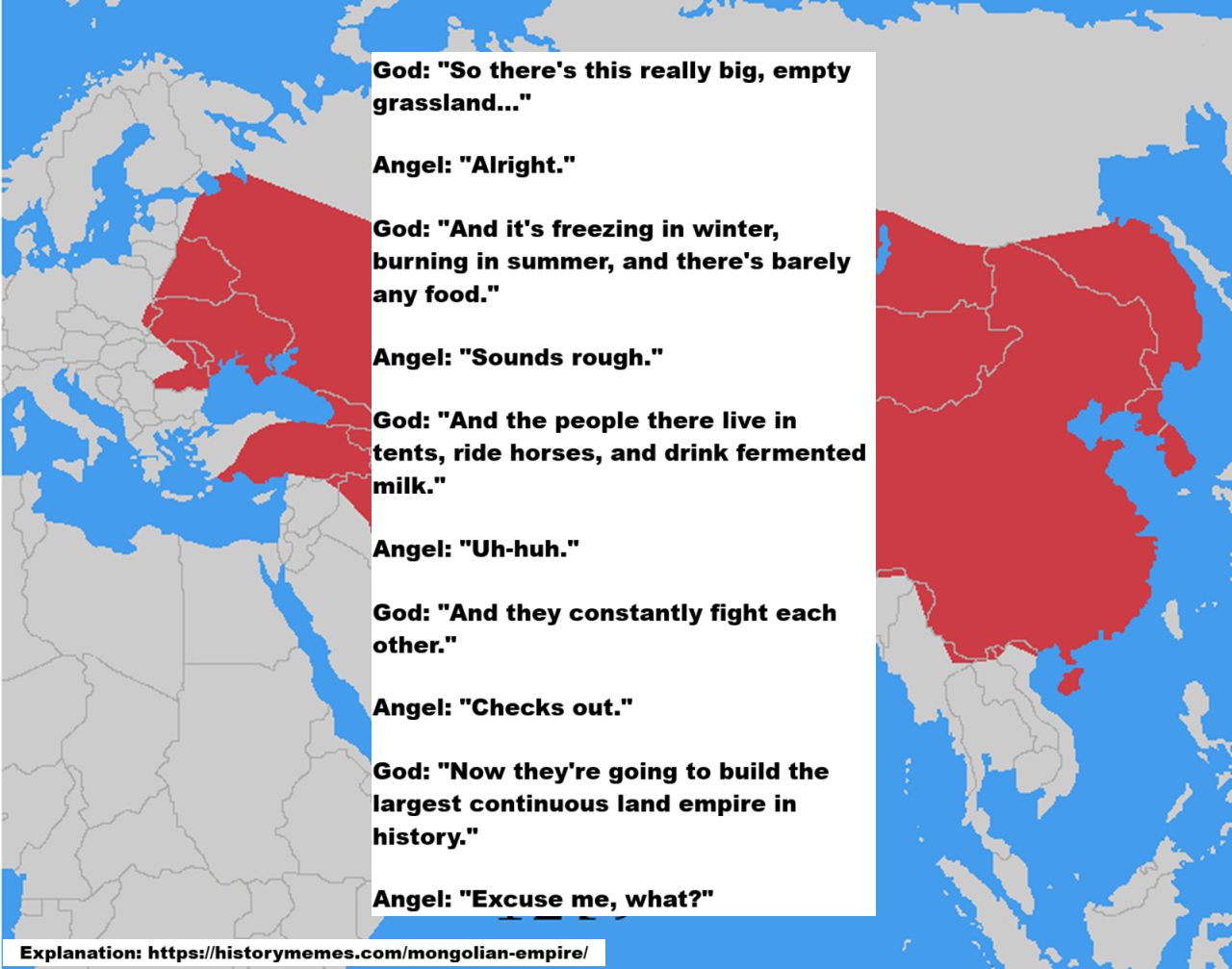
The meme above shows my feeling towards the Mongolian Empire. Mongolia today has 3.5 million people, (the same as Minneapolis–St. Paul Metro area), and I can’t see Tim Walz conquering most of Asia.
Here’s the text and a bit kore of context:
God: “So there’s this really big, empty grassland…”
Angel: “Alright.”
God: “And it’s freezing in winter, burning in summer, and there’s barely any food.”
Angel: “Sounds rough.”
God: “And the people there live in tents, ride horses, and drink fermented milk.”
Angel: “Uh-huh.”
God: “And they constantly fight each other.”
Angel: “Checks out.”
God: “Now they’re going to build the largest continuous land empire in history.”
Angel: “Excuse me, what?”
The rise of the Mongol Empire really was one of history’s great “impossible” stories: a collection of scattered nomadic clans from a cold, poor steppe becoming the rulers of the largest continuous land empire in history.
Let’s see why they defied the odds:
Geography & Demography
- The Mongolian steppe is a harsh environment: bitterly cold winters, arid summers, little farmland.
- Population was small (just a few million), so Mongols could never match sedentary empires in manpower.
- But survival in such conditions bred hardiness, mobility, and adaptability, every Mongol was effectively a trained rider and warrior by youth.
- The lack of resources pushed them outward; conquest was partly a necessity.
Military Technology & Tactics
- Composite Bow: Small, powerful, and usable on horseback, could fire further and with more power than most European longbows.
- Cavalry: Almost the entire army was mounted, giving them unmatched speed and manoeuvrability.
- Organization: Genghis Khan restructured tribal units into decimal groups (10, 100, 1,000, 10,000), breaking clan loyalties and ensuring loyalty to him.
- Discipline: Harsh laws and absolute obedience. Retreat was punishable by death, but discipline made them nearly unbeatable.
- Psychological Warfare: Reputation for brutality (massacres, terror) often caused cities to surrender without a fight.
- Adoption of Siege Tech: They lacked their own siege engines but learned from conquered peoples (Chinese engineers, Persian siege experts).
Political Leadership & Unity
- Before Genghis Khan, the Mongols were just fragmented tribes.
- Genghis (Temüjin) united them through charisma, ruthlessness, and meritocracy: he promoted based on talent, not birth.
- He created a sense of shared destiny: loyalty to the empire, not just the clan.
- Built alliances through diplomacy and marriage, then broke them if needed, highly pragmatic.
Economy
- Mongols themselves had a pastoral nomadic economy (herding, trading animals). Not enough to sustain an empire.
- Conquest provided:
- Tribute (grain, silver, silk, taxes).
- Trade routes (Silk Road under Mongol protection flourished: “Pax Mongolica”).
- Skilled labor (captured artisans, scribes, and engineers).
- They didn’t innovate economically, but they integrated conquered economies, Persia’s administration, China’s farming wealth, Muslim financial systems.
Religion & Tolerance
- Mongols practiced Tengrism (sky-god religion) with shamanism.
- Crucially, they were religiously tolerant: Christianity, Islam, Buddhism all coexisted in the empire.
- This tolerance helped them govern diverse populations without constant rebellion.
- Sometimes they even used religion diplomatically, allying with Christian kingdoms against Muslims, or vice versa.
Why It Worked (Against All Odds)
- Mobility + adaptability: Could move faster than any army, live off the land, and adjust tactics.
- Fear factor: Terror was a weapon, surrender and live, resist and die.
- Leadership: Genghis Khan was a once-in-history leader who forged unity out of chaos.
- Weak neighbors: China’s Jin and Song dynasties were divided, Persia fractured, Kievan Rus disunited, Islamic caliphate weakened. The timing was perfect.
- Networks: By conquering, they didn’t destroy but integrated, using Chinese engineers, Persian administrators, Muslim doctors.
Why It Didn’t Last
- Succession problems: Genghis Khan’s empire was divided among his sons (Ögedei, Chagatai, Jochi, Tolui). This worked short-term but later created rival khanates.
- Overexpansion: Huge territory (from Korea to Hungary) was impossible to govern centrally. Communication and logistics were stretched thin.
- Cultural Absorption: In China, the Mongols adopted Chinese ways; in Persia, they converted to Islam. Each khanate became “local” over time.
- No stable institutions: Mongol rule depended on strong khans. Once weak leaders appeared, the empire fractured.
- Demographic limits: The Mongols were few, ruling millions in China, Persia, and Russia. Over time, they were assimilated by the very peoples they ruled.
- Plague: The Black Death (spread along Mongol trade routes) devastated populations and undermined trade, weakening the empire.
Also see: What If the Mongol Empire Reunited….? and Map Of The Mongolian Diaspora In The World.
Books about the Mongolian Empire:
Leave a Reply